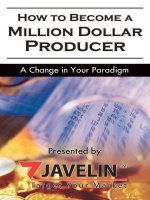How to Prepare a Case Study ppt
Bạn đang xem bản rút gọn của tài liệu. Xem và tải ngay bản đầy đủ của tài liệu tại đây (74.98 KB, 10 trang )
How to Prepare a Case Study
While there is no one definitive "Case Method" or approach, there
are common steps that most approaches recommend be followed in
tackling a case study. It is inevitable that different lecturers will tell
you to do things differently, this is part of life and will also be part
of working for others. This variety is beneficial since it will show you
different ways of approaching decision making. What follows is
intended to be a rather general approach, portions of which have
been taken from an excellent book entitled, Learning with Cases,
by Erskine, Leenders, & Mauffette-Leenders, published by the
Richard Ivey School of Business, The University of Western Ontario,
1997.
1. Before the class discussion:
1. Read the case study
2. Use the Short Cycle Process to familiarise yourself with
the case.
3. Use the Long Cycle Process to analyse the case
4. Usually there will be group meetings to discuss your
ideas.
5. Write notes on the case for your reference
2. In the class discussion:
1. Someone will start the discussion, usually at the
prompting of the lecturer.
2. Listen carefully and take notes. Pay close attention to
assumptions. Insist that they are clearly stated.
3. Take part in the discussion. Your contribution is
important, and is likely a part of your evaluation for the
course.
3. After the class discussion:
1. Review ASAP after the class. Note what the key concept
was and how the case fits into the course.
Preparing A Case Study
It helps to have a system when sitting down to prepare a case
study as the amount of information and issues to be resolved can
initially seem quite overwhelming. The following is a good way to
start.
Step 1: The Short Cycle Process
1. Quickly read the case. If it is a long case, at this stage you
may want to read only the first few and last paragraphs. You
should then be able to
2. Answer the following questions:
1. Who is the decision maker in this case, and what is their
position and responsibilities?
2. What appears to be the issue (of concern, problem,
challenge, or opportunity) and its significance for the
organisation?
3. Why has the issue arisen and why is the decision maker
involved now?
4. When does the decision maker have to decide, resolve,
act or dispose of the issue? What is the urgency to the
situation?
3. Take a look at the Exhibits to see what numbers have been
provided.
4. Review the case subtitles to see what areas are covered in
more depth.
5. Review the case questions if they have been provided. This
may give you some clues are what the main issues are to be
resolved.
You should now be familiar with what the case study is about, and
are ready to begin the process of analysing it. You are not done
yet! Many students mistakenly believe that this is all the
preparation needed for a class discussion of a case study. If this
was the extent of your preparation, your ability to contribute to the
discussion would likely be limited to the first one quarter of the
class time allotted. You need to go further to prepare the case,
using the next step. One of the primary reasons for doing the short
cycle process is to give you an indication of how much work will
need to be done to prepare the case study properly.
Step 2: The Long Cycle Process
At this point, the task consists of two parts:
1. A detailed reading of the case, and then
2. Analysing the case.
When you are doing the detailed reading of the case study, look for
the following sections:
1. Opening paragraph: introduces the situation.
2. Background information: industry, organization, products,
history, competition, financial information, and anything else
of significance.
3. Specific (functional) area of interest: marketing, finance,
operations, human resources, or integrated.
4. The specific problem or decision(s) to be made.
5. Alternatives open to the decision maker, which may or may
not be stated in the case.
6. Conclusion: sets up the task, any constraints or limitations,
and the urgency of the situation.
Most, but not all case studies will follow this format. The purpose
here is to thoroughly understand the situation and the decisions
that will need to be made. Take your time, make notes, and keep
focussed on your objectives.
Analyzing the case should take the following steps:
1. Defining the issue(s)
2. Analysing the case data
3. Generating alternatives
4. Selecting decision criteria
5. Analysing and evaluating alternatives
6. Selecting the preferred alternative
7. Developing an action/implementation plan
Defining the issue(s)/Problem Statement
The problem statement should be a clear, concise statement of
exactly what needs to be addressed. This is not easy to write! The
work that you did in the short cycle process answered the basic
questions. Now it is time to decide what the main issues to be
addressed are going to be in much more detail. Asking yourself the
following questions may help:
1. What appears to be the problem(s) here?
2. How do I know that this is a problem? Note that by
asking this question, you will be helping to differentiate the
symptoms of the problem from the problem itself. Example:
while declining sales or unhappy employees are a problem to
most companies, they are in fact, symptoms of underlying
problems which need to addressed.
3. What are the immediate issues that need to be
addressed? This helps to differentiate between issues that
can be resolved within the context of the case, and those that
are bigger issues that needed to addressed at a another time
(preferably by someone else!).
4. Differentiate between importance and urgency for the
issues identified. Some issues may appear to be urgent, but
upon closer examination are relatively unimportant, while
others may be far more important (relative to solving our
problem) than urgent. You want to deal with important issues
in order of urgency to keep focussed on your objective.
Important issues are those that have a significant effect on:
1. profitability,
2. strategic direction of the company,
3. source of competitive advantage,
4. morale of the company's employees, and/or
5. customer satisfaction.
The problem statement may be framed as a question, eg: What
should Joe do? or How can Mr Smith improve market share? Usually
the problem statement has to be re-written several times during the
analysis of a case, as you peel back the layers of symptoms or
causation.
Analysing Case Data
In analysing the case data, you are trying to answer the following:
1. Why or how did these issues arise? You are trying to
determine cause and effect for the problems identified. You
cannot solve a problem that you cannot determine the cause
of! It may be helpful to think of the organization in question
as consisting of the following components:
1. resources, such as materials, equipment, or supplies,
and
2. people who transform these resources using
3. processes, which creates something of greater value.
Now, where are the problems being caused within this
framework, and why?
2. Who is affected most by this issues? You are trying to
identify who are the relevant stakeholders to the situation,
and who will be affected by the decisions to be made.
3. What are the constraints and opportunities implicit to
this situation? It is very rare that resources are not a
constraint, and allocations must be made on the assumption
that not enough will be available to please everyone.
4. What do the numbers tell you? You need to take a look at
the numbers given in the case study and make a judgement
as to their relevance to the problem identified. Not all
numbers will be immediately useful or relevant, but you need
to be careful not to overlook anything. When deciding to
analyze numbers, keep in mind why you are doing it, and
what you intend to do with the result. Use common sense and
comparisons to industry standards when making judgements
as to the meaning of your answers to avoid jumping to
conclusions.
Generating Alternatives
This section deals with different ways in which the problem can be
resolved. Typically, there are many (the joke is at least three), and
being creative at this stage helps. Things to remember at this stage
are:
1. Be realistic! While you might be able to find a dozen
alternatives, keep in mind that they should be realistic and fit
within the constraints of the situation.
2. The alternatives should be mutually exclusive, that is, they
cannot happen at the same time.
3. Not making a decision pending further investigation is
not an acceptable decision for any case study that you will
analyse. A manager can always delay making a decision to
gather more information, which is not managing at all! The
whole point to this exercise is to learn how to make good
decisions, and having imperfect information is normal for
most business decisions, not the exception.
4. Doing nothing as in not changing your strategy can be a
viable alternative, provided it is being recommended for the
correct reasons, as will be discussed below.
5. Avoid the meat sandwich method of providing only two
other clearly undesirable alternatives to make one reasonable
alternative look better by comparison. This will be painfully
obvious to the reader, and just shows laziness on your part in
not being able to come up with more than one decent
alternative.
6. Keep in mind that any alternative chosen will need to be
implemented at some point, and if serious obstacles exist to
successfully doing this, then you are the one who will look bad
for suggesting it.
Once the alternatives have been identified, a method of evaluating
them and selecting the most appropriate one needs to be used to
arrive at a decision.
Key Decision Criteria
A very important concept to understand, they answer the question
of how you are going to decide which alternative is the best one to
choose. Other than choosing randomly, we will always employ some
criteria in making any decision. Think about the last time that you
make a purchase decision for an article of clothing. Why did you
choose the article that you did? The criteria that you may have used
could have been:
1. fit
2. price
3. fashion
4. colour
5. approval of friend/family
6. availability
Note that any one of these criteria could appropriately finish the
sentence, the brand/style that I choose to purchase must
These criteria are also how you will define or determine that a
successful purchase decision has been made. For a business
situation, the key decision criteria are those things that are
important to the organization making the decision, and they will be
used to evaluate the suitability of each alternative recommended.
Key decision criteria should be:
1. Brief, preferably in point form, such as
1. improve (or at least maintain) profitability,
2. increase sales, market share, or return on investment,
3. maintain customer satisfaction, corporate image,
4. be consistent with the corporate mission or strategy,
5. within our present (or future) resources and
capabilities,
6. within acceptable risk parameters,
7. ease or speed of implementation,
8. employee morale, safety, or turnover,
9. retain flexibility, and/or
10. minimize environmental impact.
2. Measurable, at least to the point of comparison, such as
alternative A will improve profitability more that alternative B.
3. Be related to your problem statement, and alternatives. If you
find that you are talking about something else, that is a sign
of a missing alternative or key decision criteria, or a poorly
formed problem statement.
Students tend to find the concept of key decision criteria very
confusing, so you will probably find that you re-write them several
times as you analyse the case. They are similar to constraints or
limitations, but are used to evaluate alternatives.
Evaluation of Alternatives
If you have done the above properly, this should be straightforward.
You measure the alternatives against each key decision criteria.
Often you can set up a simple table with key decision criteria as
columns and alternatives as rows, and write this section based on
the table. Each alternative must be compared to each criteria and
its suitability ranked in some way, such as met/not met, or in
relation to the other alternatives, such as better than, or highest.
This will be important to selecting an alternative. Another method
that can be used is to list the advantages and disadvantages
(pros/cons) of each alternative, and then discussing the short and
long term implications of choosing each. Note that this implies that
you have already predicted the most likely outcome of each of the
alternatives. Some students find it helpful to consider three
different levels of outcome, such as best, worst, and most likely, as
another way of evaluating alternatives.
Recommendation
You must have one! Business people are decision-makers; this is
your opportunity to practice making decisions. Give a justification
for your decision (use the KDC's). Check to make sure that it is one
(and only one) of your Alternatives and that it does resolve what
you defined as the Problem.









